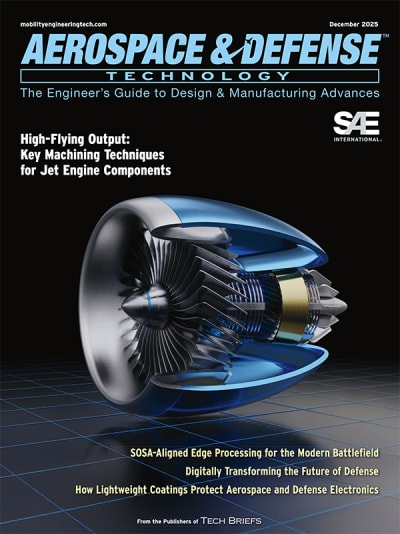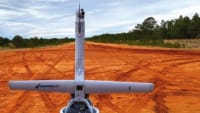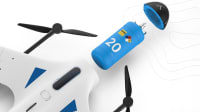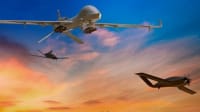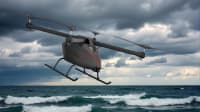Researcher Develops Autonomous UAV Refueling System
A University of Sydney researcher has designed and successfully tested a method for autonomously docking drones for refueling or recharging, in mid- air. Daniel Wilson, whose PhD research addressed the limited endurance levels of unmanned aerial vehicles (UAV) says, "At the moment, a UAV's range and endurance is constrained by the amount of fuel that can be stored on board. As you add more fuel, the weight of the aircraft increases, which means more fuel must be consumed to stay aloft."
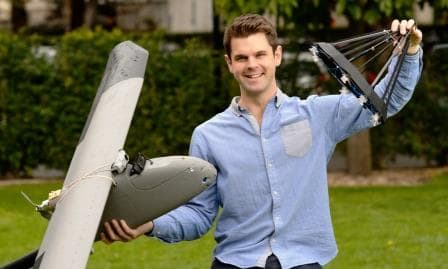
Working at the University's Australian Centre for Field Robotics and Marulan air strip, Daniel used a combination of precise measurements from an infrared camera, with GPS and inertial sensors, to allow the sky-high docking to occur. “The biggest challenge is the highly accurate and reliable relative positioning performance to allow a second aircraft to dock with a small target, in the air, and amidst turbulence," explained Daniel. He went on to say, "This type of technology is useful in situations where greatly extended persistence over an area is desirable, such as the search for the MH370.It would allow aircraft to use their fuel to search the target area, rather than flying back and forth from land. It could also be used to keep high-flying UAVs airborne, in place of satellites for communication."
As part of his ongoing efforts to meet the engineering challenges, Daniel developed an autopilot and rapid software development process which twice won him the International Simulink Design Challenge. Now successfully tested, he explains the principle behind his airborne docking design: "There are two autonomous aircraft, a leader and a follower. The leader tows a cone-shaped, parachute-like drogue. The objective is for the follower to autonomously dock its nose, within the drogue. Initially both the aircraft rendezvous to a formation position where the follower's infrared camera can observe infrared LED markers on the leader's wingtips and tail. Once docked, the follower is commanded to station for a certain amount of time to simulate refueling or recharging. The follower disconnects and resumes its mission."
"In addition to docking, this system could be used for any application that requires highly accurate positioning, relative to a static or moving target,” added Daniel. “This could include precision landing on ships, net recovery, or close formation flight."
Source :
Top Stories
INSIDERDefense
![]() F-35 Proves Nuke Drop Performance in Stockpile Flight Testing
F-35 Proves Nuke Drop Performance in Stockpile Flight Testing
INSIDERMaterials
![]() Using Ultrabright X-Rays to Test Materials for Ultrafast Aircraft
Using Ultrabright X-Rays to Test Materials for Ultrafast Aircraft
INSIDERManufacturing & Prototyping
![]() Stevens Researchers Test Morkovin's Hypothesis for Major Hypersonic Flight...
Stevens Researchers Test Morkovin's Hypothesis for Major Hypersonic Flight...
INSIDERManufacturing & Prototyping
![]() New 3D-Printable Nanocomposite Prevents Overheating in Military Electronics
New 3D-Printable Nanocomposite Prevents Overheating in Military Electronics
INSIDERRF & Microwave Electronics
![]() L3Harris Starts Low Rate Production Of New F-16 Viper Shield
L3Harris Starts Low Rate Production Of New F-16 Viper Shield
INSIDERRF & Microwave Electronics
Webcasts
Energy
![]() SAE Automotive Engineering Podcast: Additive Manufacturing
SAE Automotive Engineering Podcast: Additive Manufacturing
Manufacturing & Prototyping
![]() A New Approach to Manufacturing Machine Connectivity for the Air Force
A New Approach to Manufacturing Machine Connectivity for the Air Force
Automotive
![]() Optimizing Production Processes with the Virtual Twin
Optimizing Production Processes with the Virtual Twin
Power
![]() EV and Battery Thermal Management Strategies
EV and Battery Thermal Management Strategies
Energy
![]() How Packet Digital Is Scaling Domestic Drone Battery Manufacturing
How Packet Digital Is Scaling Domestic Drone Battery Manufacturing
Materials
![]() Advancements in Zinc Die Casting Technology & Alloys for Next-Generation...
Advancements in Zinc Die Casting Technology & Alloys for Next-Generation...

